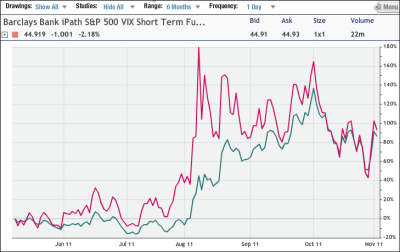There has been increasing talk recently about volatility becoming a popular new asset class, but one does not really invest in volatility: It has a zero or even negative long-term expectation, at least from an average starting point. Trading in shorter time frames, however, can make a great deal of sense.
That said, the definition of "short term" can run from seconds to weeks, which is why many of the new volatility funds are dynamic. Many insist that volatility funds should not be bought at all, while others say that any positions should be held only a matter of days at most.
The debate over "tail risk" funds and other hedging vehicles that we have cited in recent weeks is as lively as ever, and some prominent voices have said that buying into any such products is a losing long-term proposition. The CBOE PutWrite Index , when used as a benchmark, shows that selling those protective puts has outperformed the S&P 500 over the long term with less volatility.
So if volatility trading is something that we should do only in the short term, the question is when. This brings up the issue of timing, something that most people will tell you is impossible over the long term. But in a market that hasn't gone anywhere in 10 years, isn't it worth trying to find a timing system that works?
At the time this column was written, the S&P 500 was at 1233--the same level where it traded on Aug. 4, Aug. 31, Oct. 18, and a couple of times since. On those dates, the VIX was at a high of 32, 32, and 34, where it stands today. So the VIX has been pretty consistent with the level of the SPX in the last three months.
The iPath S&P 500 VIX Short-Term Futures Fund (NYSEArca:VXX), on the other hand, was at highs of $28.90, $39, and $46, while currently at $45. The VIX hit its high of 48 on Aug. 8, 200 percent above a month earlier. The VXX didn't peak until it hit $59.18 on Oct. 4, also roughly a 200 percent gain from July lows, as the VIX topped out at 46.88 that day. (The VXX is blue and the VIX purple on the chart below.)

What explains this difference? Well, it is important to remember that the VXX is composed of the two nearest-month VIX futures, with a daily roll from contracts in the front to the second month. The VIX futures are projections of where the VIX will be at expiration, so they will react differently to changes in volatility.
Normally those futures are in contango, meaning that the spot VIX reading is lower than the front-month futures price and that future is below the second month--so the daily roll is selling low and buying higher. But during times of high volatility, those futures can flip into backwardation, with the VIX cash above the front-month futures and the front-month futures trading higher than the second.
This backwardation is positive for that daily roll and adds to the performance of the fund. And looking at the chart, the difference between contango and backwardation has vast significance for the VXX.
The upshot: "Investing" in the VXX for the last three months would not have been such a bad idea.
This discussion ties into an interesting conversation that I had recently about strategies for different volatility regimes, as I believe firmly that it makes sense to have various game plans to address fluctuating volatility levels. Many traders get stuck on type of strategy and try to apply it to all market conditions, which is clearly not the best way to approach the markets.
Keeping written rules about what strategies you are going to use under different scenarios will improve your trading. It also goes back to that timing question.
An easy timing strategy for the VXX is to buy it when the VIX futures are in backwardation. Those looking to time their hedges could employ the same criteria or at least use it as a model for what type of strategies make the most sense.
(A version of this article appeared in optionMONSTER's What's the Trade? newsletter of Nov. 2. Chart courtesy of tradeMONSTER.)
More From optionMONSTER





谢谢九月,也祝您合家欢乐。